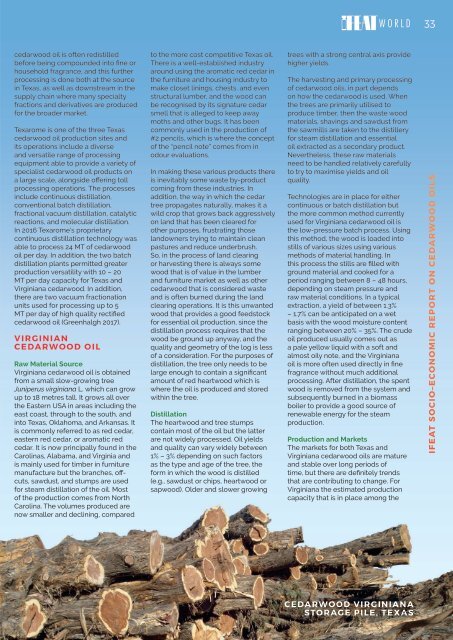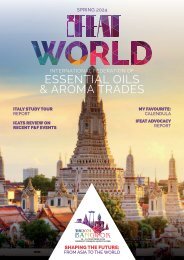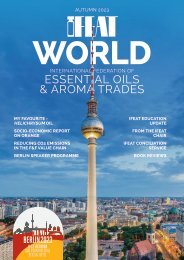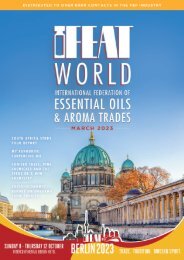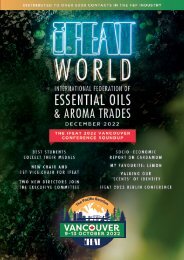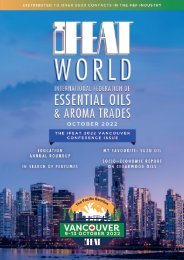IFEATWORLD July 2022
A Members' Newsletter for the International Federation of Essential Oils & Aroma Trades.
A Members' Newsletter for the International Federation of Essential Oils & Aroma Trades.
You also want an ePaper? Increase the reach of your titles
YUMPU automatically turns print PDFs into web optimized ePapers that Google loves.
WORLD 33<br />
cedarwood oil is often redistilled<br />
before being compounded into fine or<br />
household fragrance, and this further<br />
processing is done both at the source<br />
in Texas, as well as downstream in the<br />
supply chain where many specialty<br />
fractions and derivatives are produced<br />
for the broader market.<br />
Texarome is one of the three Texas<br />
cedarwood oil production sites and<br />
its operations include a diverse<br />
and versatile range of processing<br />
equipment able to provide a variety of<br />
specialist cedarwood oil products on<br />
a large scale, alongside offering toll<br />
processing operations. The processes<br />
include continuous distillation,<br />
conventional batch distillation,<br />
fractional vacuum distillation, catalytic<br />
reactions, and molecular distillation.<br />
In 2016 Texarome’s proprietary<br />
continuous distillation technology was<br />
able to process 24 MT of cedarwood<br />
oil per day. In addition, the two batch<br />
distillation plants permitted greater<br />
production versatility with 10 – 20<br />
MT per day capacity for Texas and<br />
Virginiana cedarwood. In addition,<br />
there are two vacuum fractionation<br />
units used for processing up to 5<br />
MT per day of high quality rectified<br />
cedarwood oil (Greenhalgh 2017).<br />
VIRGINIAN<br />
CEDARWOOD OIL<br />
Raw Material Source<br />
Virginiana cedarwood oil is obtained<br />
from a small slow-growing tree<br />
Juniperus virginiana L. which can grow<br />
up to 18 metres tall. It grows all over<br />
the Eastern USA in areas including the<br />
east coast, through to the south, and<br />
into Texas, Oklahoma, and Arkansas. It<br />
is commonly referred to as red cedar,<br />
eastern red cedar, or aromatic red<br />
cedar. It is now principally found in the<br />
Carolinas, Alabama, and Virginia and<br />
is mainly used for timber in furniture<br />
manufacture but the branches, offcuts,<br />
sawdust, and stumps are used<br />
for steam distillation of the oil. Most<br />
of the production comes from North<br />
Carolina. The volumes produced are<br />
now smaller and declining, compared<br />
to the more cost competitive Texas oil.<br />
There is a well-established industry<br />
around using the aromatic red cedar in<br />
the furniture and housing industry to<br />
make closet linings, chests, and even<br />
structural lumber, and the wood can<br />
be recognised by its signature cedar<br />
smell that is alleged to keep away<br />
moths and other bugs. It has been<br />
commonly used in the production of<br />
#2 pencils, which is where the concept<br />
of the “pencil note” comes from in<br />
odour evaluations.<br />
In making these various products there<br />
is inevitably some waste by-product<br />
coming from these industries. In<br />
addition, the way in which the cedar<br />
tree propagates naturally, makes it a<br />
wild crop that grows back aggressively<br />
on land that has been cleared for<br />
other purposes, frustrating those<br />
landowners trying to maintain clean<br />
pastures and reduce underbrush.<br />
So, in the process of land clearing<br />
or harvesting there is always some<br />
wood that is of value in the lumber<br />
and furniture market as well as other<br />
cedarwood that is considered waste<br />
and is often burned during the land<br />
clearing operations. It is this unwanted<br />
wood that provides a good feedstock<br />
for essential oil production, since the<br />
distillation process requires that the<br />
wood be ground up anyway, and the<br />
quality and geometry of the log is less<br />
of a consideration. For the purposes of<br />
distillation, the tree only needs to be<br />
large enough to contain a significant<br />
amount of red heartwood which is<br />
where the oil is produced and stored<br />
within the tree.<br />
Distillation<br />
The heartwood and tree stumps<br />
contain most of the oil but the latter<br />
are not widely processed. Oil yields<br />
and quality can vary widely between<br />
1% – 3% depending on such factors<br />
as the type and age of the tree, the<br />
form in which the wood is distilled<br />
(e.g., sawdust or chips, heartwood or<br />
sapwood). Older and slower growing<br />
trees with a strong central axis provide<br />
higher yields.<br />
The harvesting and primary processing<br />
of cedarwood oils, in part depends<br />
on how the cedarwood is used. When<br />
the trees are primarily utilised to<br />
produce timber, then the waste wood<br />
materials, shavings and sawdust from<br />
the sawmills are taken to the distillery<br />
for steam distillation and essential<br />
oil extracted as a secondary product.<br />
Nevertheless, these raw materials<br />
need to be handled relatively carefully<br />
to try to maximise yields and oil<br />
quality.<br />
Technologies are in place for either<br />
continuous or batch distillation but<br />
the more common method currently<br />
used for Virginiana cedarwood oil is<br />
the low-pressure batch process. Using<br />
this method, the wood is loaded into<br />
stills of various sizes using various<br />
methods of material handling. In<br />
this process the stills are filled with<br />
ground material and cooked for a<br />
period ranging between 8 – 48 hours,<br />
depending on steam pressure and<br />
raw material conditions. In a typical<br />
extraction, a yield of between 1.3%<br />
– 1.7% can be anticipated on a wet<br />
basis with the wood moisture content<br />
ranging between 20% – 35%. The crude<br />
oil produced usually comes out as<br />
a pale yellow liquid with a soft and<br />
almost oily note, and the Virginiana<br />
oil is more often used directly in fine<br />
fragrance without much additional<br />
processing. After distillation, the spent<br />
wood is removed from the system and<br />
subsequently burned in a biomass<br />
boiler to provide a good source of<br />
renewable energy for the steam<br />
production.<br />
Production and Markets<br />
The markets for both Texas and<br />
Virginiana cedarwood oils are mature<br />
and stable over long periods of<br />
time, but there are definitely trends<br />
that are contributing to change. For<br />
Virginiana the estimated production<br />
capacity that is in place among the<br />
IFEAT SOCIO–ECONOMIC REPORT ON CEDARWOOD OILS<br />
CEDARWOOD VIRGINIANA<br />
STORAGE PILE, TEXAS


